Effect of the Addition of Carbon Nanomaterials on Electrical and Mechanical Properties of Wood Plastic Composites
Abstract
:1. Introduction
2. Experimental
2.1. Materials
2.2. Sample Preparation
2.3. Characterization
2.3.1. Scanning Electron Microscopy
2.3.2. Electrical Properties
2.3.3. Mechanical Properties
3. Results and Discussion
3.1. Electrical Properties
3.2. Mechanical Poperties
3.3. Morphological Properties
4. Conclusions
Acknowledgments
Author Contributions
Conflicts of Interest
References
- Wang, Q.W.; Wang, W.H.; Song, Y.M. Wood-Plastic Composites and Products; Chemical Industry Press: Beijing, China, 2007. [Google Scholar]
- Adhikary, K.B.; Pang, S.S.; Staiger, M.P. Effects of the accelerated freeze-thaw cycling on physical and mechanical properties of wood flour-recycled thermoplastic composites. Polym. Compos. 2010, 31, 185–194. [Google Scholar] [CrossRef]
- Birm, J.K.; Fei, Y.; Han, G.; Wang, Q.W.; Wu, Q.L. Mechanical and physical properties of core–shell structured wood plastic composites: Effect of shells with hybrid mineral and wood fillers. Compos. Part B 2013, 45, 1040–1048. [Google Scholar]
- Rohan, M.B.; Allan, C.; Manalo, W.K.; Kintak, L. An overview of mechanical properties and durability of glass-fibre reinforced recycled mixed plastic waste composites. Mater. Des. 2014, 62, 98–112. [Google Scholar]
- Christian, L.; Till, A.; Thomas, S.; Jonas, L.; Wilfried, V.L.; Bodo, F. Influence of carbon nanoparticle modification on the mechanical and electrical properties of epoxy in small volumes. J. Colloid. Interface Sci. 2017, 505, 620–632. [Google Scholar]
- Taherian, R. Experimental and analytical model for the electrical conductivity of polymer-based nanocomposites. Compos. Sci. Technol. 2016, 123, 17–31. [Google Scholar] [CrossRef]
- Pan, Y.; Liu, X.; Hao, X. Enhancing the electrical conductivity of carbon black-filled immiscible polymer blends by tuning the morphology. Eur. Polym. J. 2016, 78, 106–115. [Google Scholar] [CrossRef]
- Yang, H.; Gong, J.; Wen, X. Effect of carbon black on improving thermal stability, flame retardancy and electrical conductivity of polypropylene/carbon fiber composites. Compos. Sci. Technol. 2015, 113, 31–37. [Google Scholar] [CrossRef]
- Heo, S.I.; Yun, J.C.; Han, K.S. Influence of particle size and shape on electrical and mechanical properties of graphite reinforced conductive polymer composites for the bipolar plate of PEM fuel cells. Adv. Compos. Mater. 2006, 15, 115–126. [Google Scholar] [CrossRef]
- Wu, C.S.; Liao, H.T. Study on the preparation and characterization of biodegradable polylactide/multi-walled carbon nanotubes nanocomposites. Polymer 2007, 48, 4449–4458. [Google Scholar] [CrossRef]
- Bauhofer, W.; Kovacs, J.Z. A review and analysis of electrical percolation in carbon nanotube polymer composites. Compos. Sci. Technol. 2009, 69, 1486–1498. [Google Scholar] [CrossRef]
- Smith, J.G.; Delozier, D.M.; Connell, J.W.; Watson, K.A. Carbon nanotubeconductive additive-space durable polymer nanocomposite films for electrostatic charge dissipation. Polymer 2004, 45, 6133–6142. [Google Scholar] [CrossRef]
- Sun, L.; Warren, G.L.; Reilly, J.Y.; Everett, W.N.; Lee, S.M.; Davis, D. Mechanical properties of surface-functionalized SWCNT/epoxy composites. Carbon 2008, 46, 320–328. [Google Scholar] [CrossRef]
- Gardea, F.; Lagoudas, D.C. Characterization of electrical and thermal properties of carbon nanotube/epoxy composites. Compos. Part B 2014, 56, 611–620. [Google Scholar] [CrossRef]
- Moisala, A.; Li, Q.; Kinloch, A. Thermal and electrical conductivity of single and multi-walled carbon nanotube epoxy composites. Compos. Sci. Technol. 2006, 66, 1285–1288. [Google Scholar] [CrossRef]
- Smith, M.K.; Singh, V.; Kalaitzidou, K.; Cola, B.A. High thermal and electrical conductivity of template fabricated P3HT/MWCNT composite nanofibers. ACS Appl. Mater. Interfaces 2016, 8, 14788–14794. [Google Scholar] [CrossRef] [PubMed]
- Qu, M.; Nilsson, F.; Qin, Y.; Yang, G.; Pan, Y.; Liu, X.; Hernandez Rodriguez, G.; Chen, J.; Zhang, C.; Schubert, D.W. Electrical conductivity and mechanical properties of melt-spun ternary composites comprising PMMA, carbon fibers and carbon black. Compos. Sci. Technol. 2017, 150, 24–31. [Google Scholar] [CrossRef]
- Stephan, R.; Arnon, L.; Gil, U.; Galde, B. Analysis of microstructural induced enhancement of electromechanical coupling in soft dielectrics. Appl. Phys. Lett. 2013, 102, 151905. [Google Scholar]
- Mehmet, A.; Mehmet, A.T. Polymer nanocomposites via click chemistry reactions. Polymers 2017, 9, 499–523. [Google Scholar]
- Hsieh, T.H.; Kinloch, A.J.; Taylor, A.C.; Kinloch, I.A. The effect of carbon nanotubes on the fracture toughness and fatigue performance of a thermosetting epoxy polymer. J. Mater. Sci. 2011, 46, 7525–7535. [Google Scholar] [CrossRef]
- Zhou, S.X.; Chang, S.W.; Xu, J.Z.; Du, H.D.; Li, B.H.; Xu, C.J.; Kang, F.Y. Modeling the in-plane thermal conductivity of a graphite/polymer composite sheet with a very high content of natural flake graphite. Carbon 2012, 50, 5052–5061. [Google Scholar] [CrossRef]
- Tchoudakov, R.; Breuer, O.; Narkis, M. Conductive polymer blends with low carbon black loading: Polypropylene/polyamide. Polym. Eng. Sci. 1996, 36, 1336–1346. [Google Scholar] [CrossRef]
- Li, Y.; Wang, S.F.; Zhang, Y. Electrical Properties and Morphology of Polypropylene/EpoxylGlass fiber Composites Filled with Carbon Black. J. Appl. Polym. Sci. 2005, 98, 1142–1149. [Google Scholar] [CrossRef]
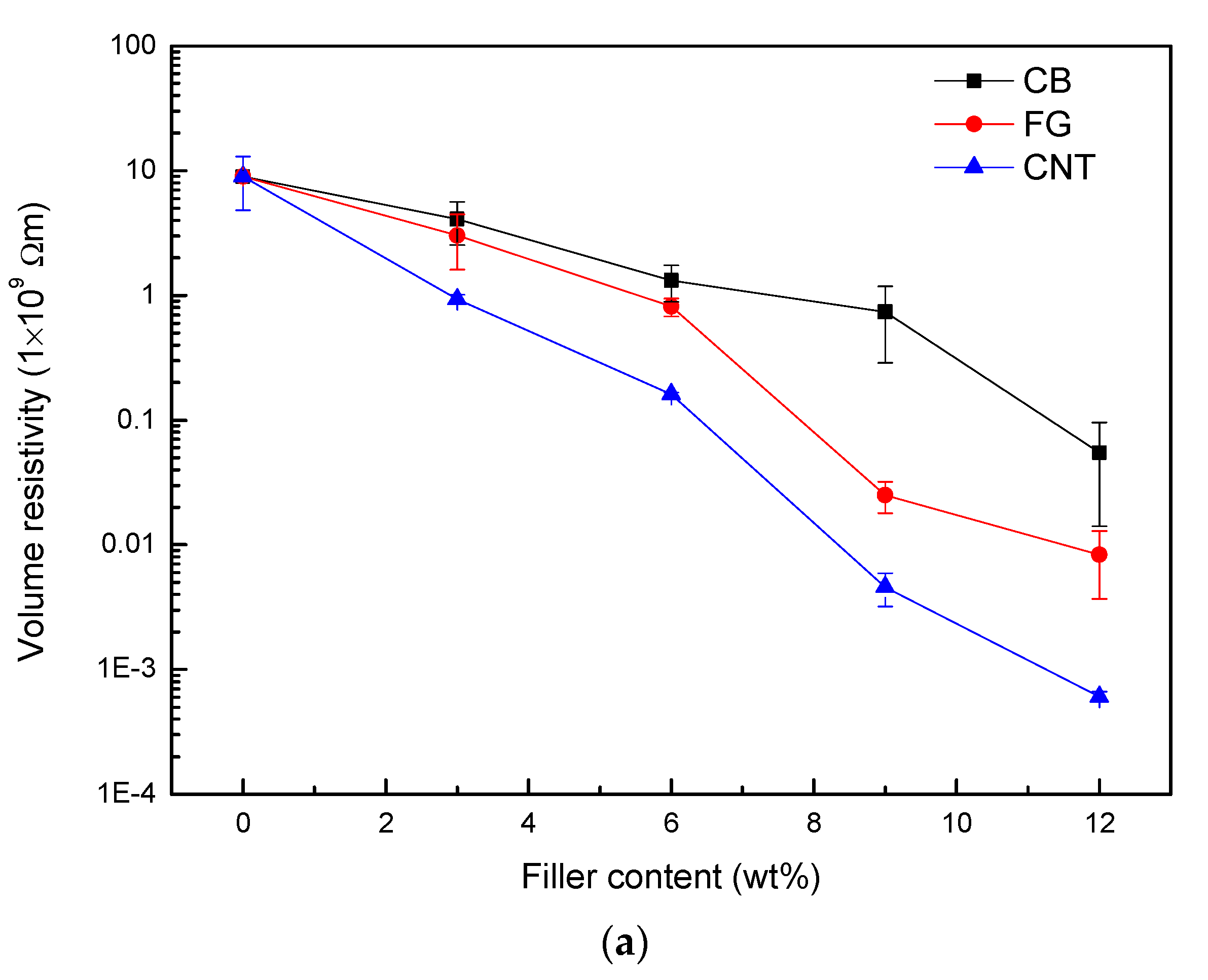
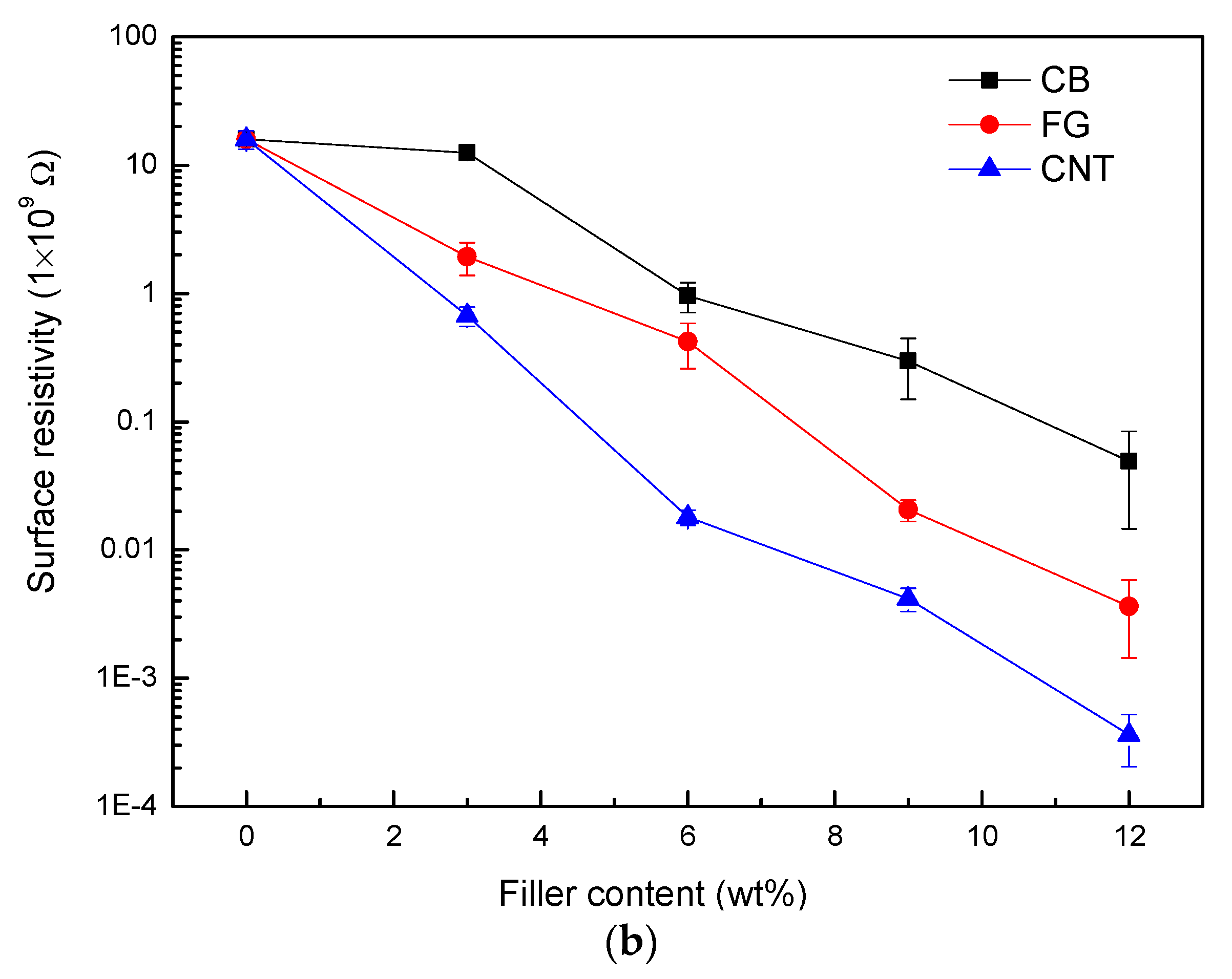
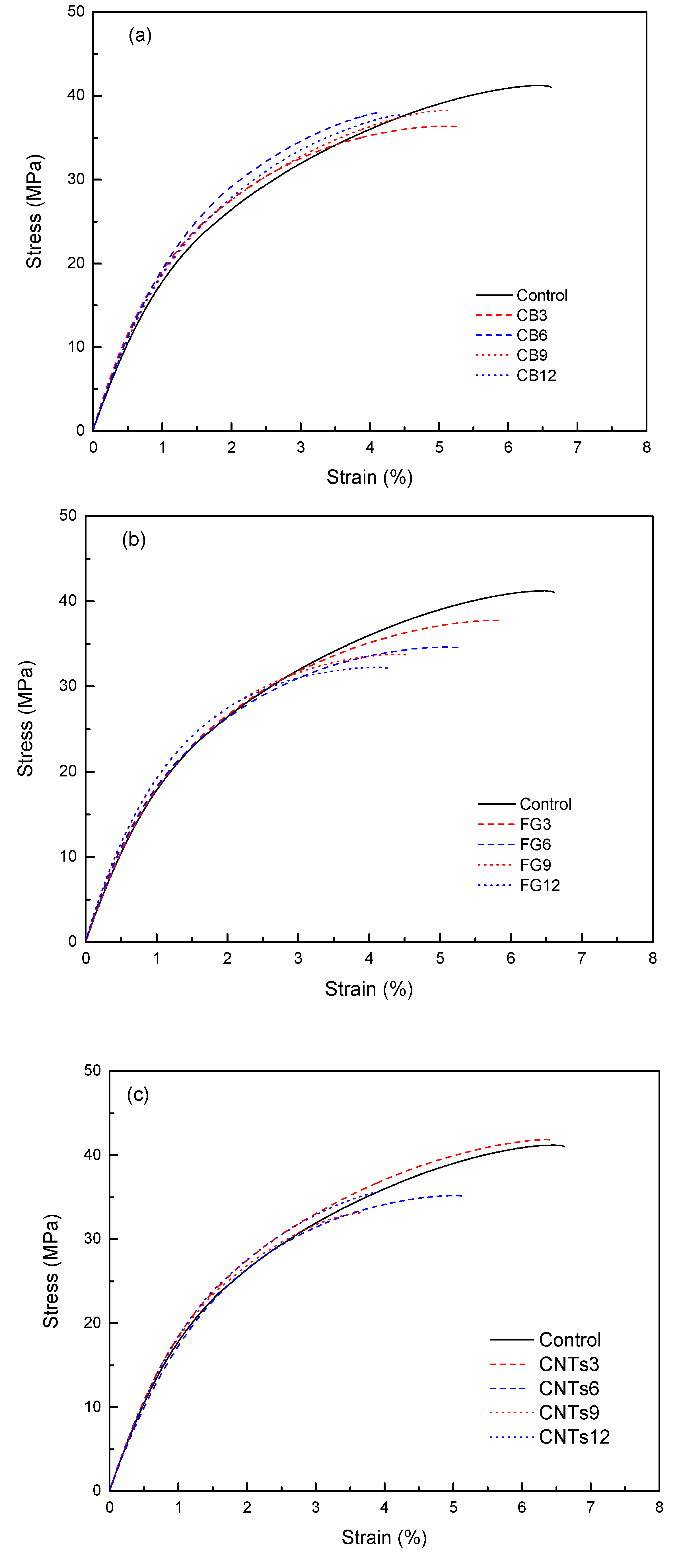
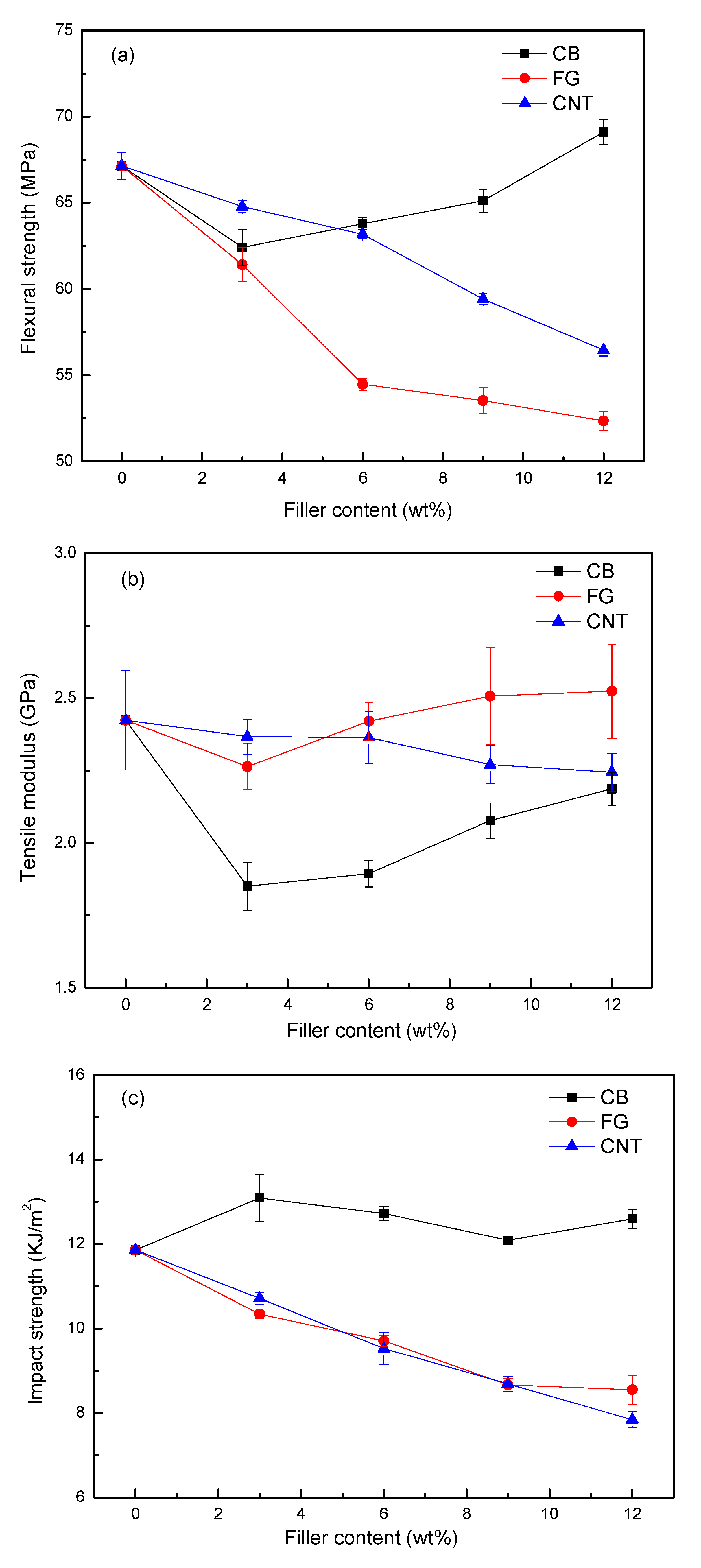
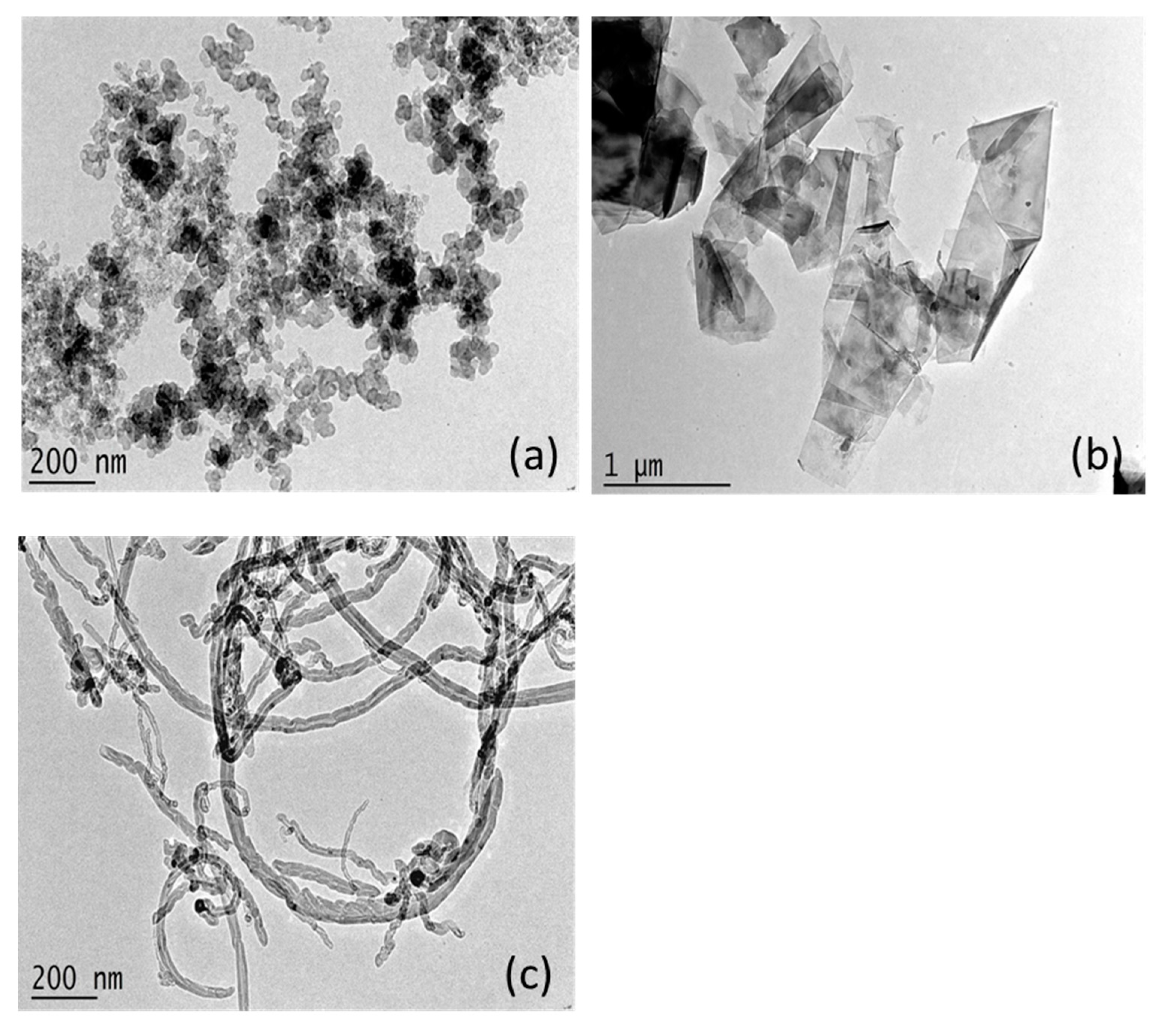

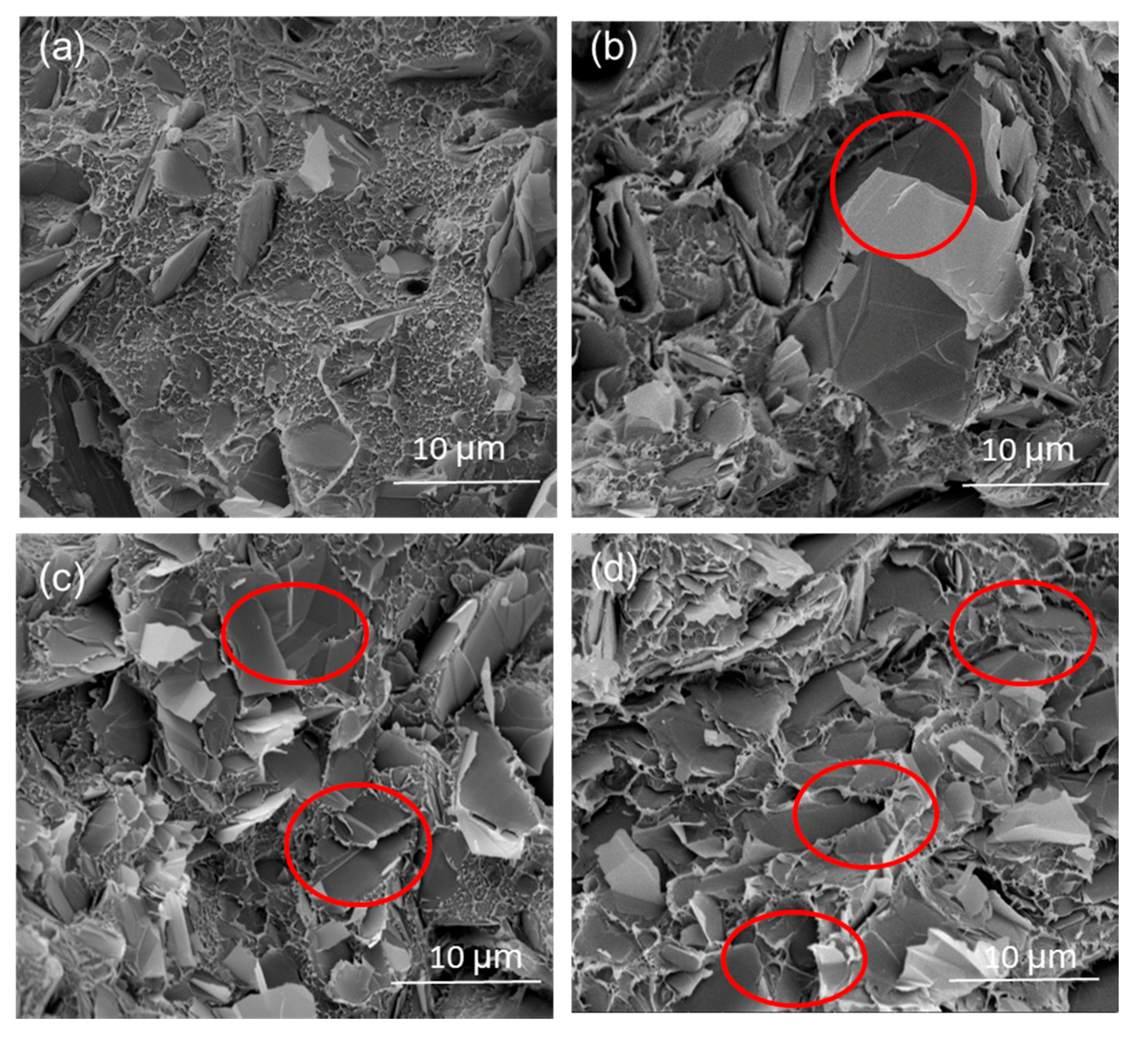
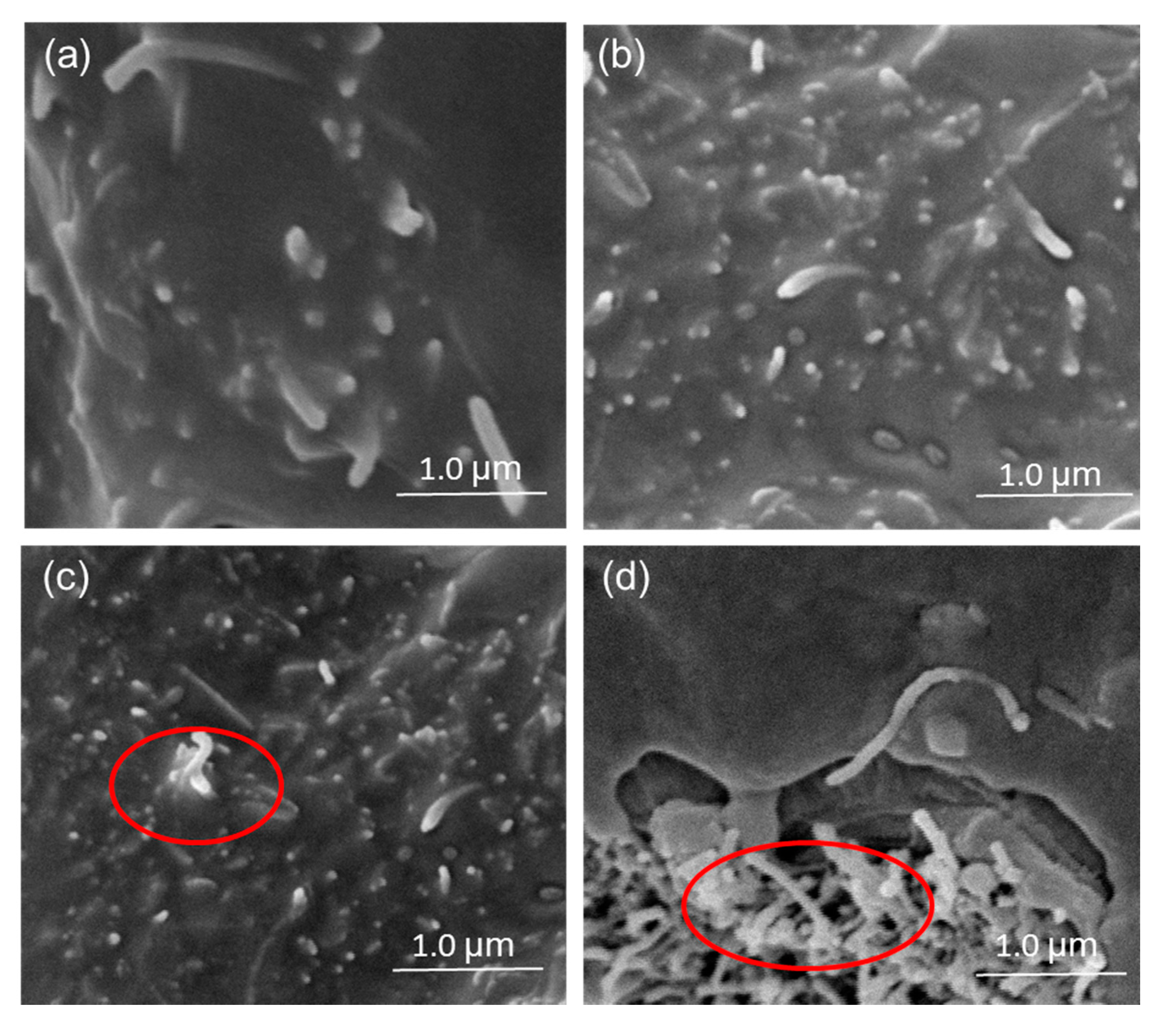
| Sample | WF (wt %) | PE (wt %) | CB (wt %) | FG (wt %) | CNTs (wt %) |
|---|---|---|---|---|---|
| Control | 60 | 40 | 0 | 0 | 0 |
| CB3 | 58 | 39 | 3 | 0 | 0 |
| CB6 | 56 | 38 | 6 | 0 | 0 |
| CB9 | 54 | 37 | 9 | 0 | 0 |
| CB12 | 52 | 36 | 12 | 0 | 0 |
| FG3 | 58 | 39 | 0 | 3 | 0 |
| FG6 | 56 | 38 | 0 | 6 | 0 |
| FG9 | 54 | 37 | 0 | 9 | 0 |
| FG12 | 52 | 36 | 0 | 12 | 0 |
| CNTs3 | 58 | 39 | 0 | 0 | 3 |
| CNTs6 | 56 | 38 | 0 | 0 | 6 |
| CNTs9 | 54 | 37 | 0 | 0 | 9 |
| CNTs12 | 52 | 36 | 0 | 0 | 12 |
© 2017 by the authors. Licensee MDPI, Basel, Switzerland. This article is an open access article distributed under the terms and conditions of the Creative Commons Attribution (CC BY) license (http://creativecommons.org/licenses/by/4.0/).
Share and Cite
Zhang, X.; Hao, X.; Hao, J.; Wang, Q. Effect of the Addition of Carbon Nanomaterials on Electrical and Mechanical Properties of Wood Plastic Composites. Polymers 2017, 9, 620. https://doi.org/10.3390/polym9110620
Zhang X, Hao X, Hao J, Wang Q. Effect of the Addition of Carbon Nanomaterials on Electrical and Mechanical Properties of Wood Plastic Composites. Polymers. 2017; 9(11):620. https://doi.org/10.3390/polym9110620
Chicago/Turabian StyleZhang, Xingli, Xiaolong Hao, Jianxiu Hao, and Qingwen Wang. 2017. "Effect of the Addition of Carbon Nanomaterials on Electrical and Mechanical Properties of Wood Plastic Composites" Polymers 9, no. 11: 620. https://doi.org/10.3390/polym9110620





